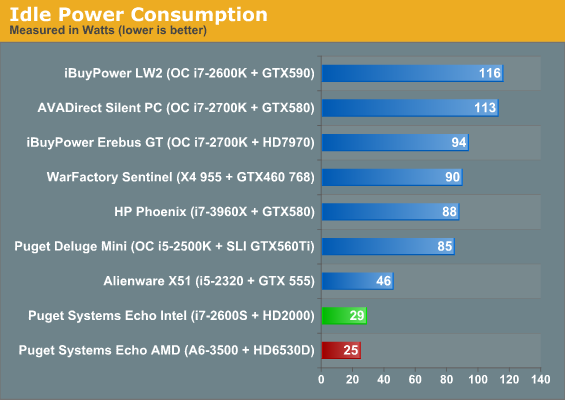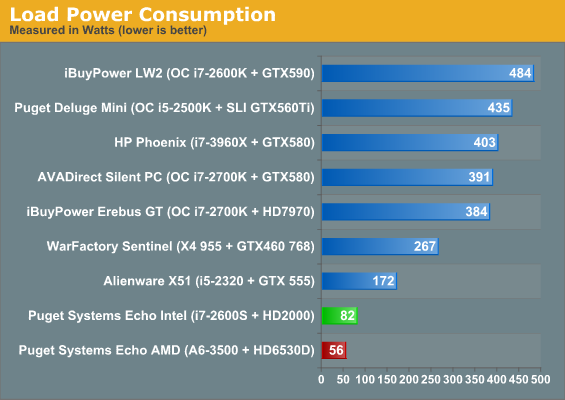Puget Systems Echo: Intel and AMD Showdown at 65 Watts
by Dustin Sklavos on March 21, 2012 2:35 AM EST- Posted in
- Systems
- AMD
- Intel
- Mini ITX
- Sandy Bridge
- Llano
- boutique
- Mini-Tower
Build Quality and Part Selection
Given the small nature of the Antec ISK-110 enclosures Puget Systems employs for their Echo I systems, it's not going to be much of a surprise that there's really only so much they can do to make build quality stand out. For what it's worth, the systems are put together as well as one can expect. Both use stock coolers from AMD and Intel, but given the low TDPs of the two processors (as well as the cramped confines of the enclosure) these coolers are never given much of a workout. Cabling is routed as well as can be expected, and Puget Systems filled both of the 2.5" drive bays. These systems really are packed to the gills.
.jpg)
This is a good time to bring up one of the ways Puget Systems distinguishes themselves from other boutiques, though. If you opt to configure a system on their site, you're going to find the number of available components substantially lower than you will from any other boutique. This has to do with their validation procedures; Puget is extremely picky about the parts they include in the desktops they ship and while I'd like to see this confidence reflected in a longer warranty than just one year, I've seen enough of their data (and their customer feedback) to corroborate their claims. It's the reason you only see Intel SSDs in their systems, for example.
It's also part of the reason why our AMD system is fighting a bit of an unfair fight, a point we brought up with Puget Systems and one they recognized. It's well known that Llano will use all the memory bandwidth it can get its hands on, while Sandy Bridge is much less sensitive. Puget hasn't qualified any 8GB DDR3-1600 DIMMs for deployment in any of their builds, and so they erred on memory capacity instead of speed. In conversations via e-mail, they even admitted this was probably a mistake in this instance. The problem is that they also don't offer any 2GB or 4GB DDR3-1600 DIMMs for the AMD-based system, either, when they do have 4GB DDR3-1600 DIMMs qualified for other builds.
As an aside, I did contact Puget Systems and ask why their parts warranty period was so limited compared to other boutiques, and their rationale is actually a fairly sound one: there's just no guarantee that the replacement parts will continue to be available for three years, given how fast hardware turns over in this industry. They don't feel a standard three year warranty is something they can in good conscience live up to, and so the three year warranty upgrade they offer is actually in place to cover the costs of offering brand new kit to replace defunct hardware should the need arise.
Heat and Noise
While I wasn't expecting too much in the way of thermal issues even with the stock cooling, I felt like noise could've gone either way when I pulled the two Echo systems out of their boxes. The side panel above the motherboard is completely ventilated, allowing fresh air to circulate inside the enclosure. That's great for cooling, but does absolutely nothing to muffle noise.
Thankfully, the circulating cool air does wonders to keep either heatsink's fan from having to work particularly hard. Neither system is actually audible while running unless you put your ear up to the open side; any kind of ambient noise in the room will muffle them. The result is that both systems never see temperatures above the low 60C on the cores, and noise is essentially a non-issue unless you're looking for a "silent" system.
Power Consumption
Most of the test results up to this point have been fairly predictable, but power consumption was a big surprise and a pretty stunning upset. Rather than build you up to it, I'll just show you.


At both idle and load, the AMD-based system beats the Intel-based one. Look at the load numbers in particular; the A6-3500 is able to beat the Intel Core i7-2600S by nearly thirty watts. I expected both to be frugal, but the A6-3500 is actually performing well under its rated wattage.


_thumb.jpg)
_thumb.jpg)
_thumb.jpg)
_thumb.jpg)
_thumb.jpg)
_thumb.jpg)








62 Comments
View All Comments
djfourmoney - Thursday, April 12, 2012 - link
Same here, I need to buy some USB stuff since I have DirecTV and internal PCI HDTV Tuners. Just adds to the budget, I really can't afford to spend the extra $135 (Case, USB Combo Tuner, $15 extra for Mini-ITX)Mothergoose729 - Wednesday, March 21, 2012 - link
In the review, the power consumption of each platform was tested only under CPU load. This is inaccurate and unfair because the GPU power consumption contributes a lot to heat and detracts from efficiency. A combination of furmark GPU torture test and a CPU intensive load tester is needed to get an accurate measurement of the power consumption of these chips.Dustin Sklavos - Wednesday, March 21, 2012 - link
Incorrect. The systems are tested under load, CPU and GPU combined. I ran the stress test in AIDA64, stressing the CPU, GPU, and system memory. Previous results used whatever the most stressful situation I could find was to maximize power consumption; sometimes it was Mafia II, sometimes it was Left 4 Dead 2, sometimes it was AIDA64. My goal is consistently to maximize the power consumption, and the CPU and GPU are being stressed in tandem here.Mothergoose729 - Wednesday, March 21, 2012 - link
In the review, both CPU fit a 65 watt envelope. While it is true that AMD A8 processors feature more cores and better graphics, they also have a much higher TDP. To my knoweledge, the A6 processor in this review is the fastest or one of the fastest chips that is under 65 watts.BornDaemon - Wednesday, March 21, 2012 - link
Registered just to post this - this is a SFF with a low noise output and small energy footprint. Why was this not tested as a HTPC, looking at different outputs, image quality analysis between HD2000 and the AMD chip, etc? Seems a lot more likely it will be used hooked up to a TV than as a gaming rig, in my mind.HW_mee - Thursday, March 22, 2012 - link
I believe Anadtech already has a comparison of the Intel HD graphics and the Llano GPU somewhere on the site making such an analysis worthless.http://www.anandtech.com/show/4479/amd-a83850-an-h...
chuckula - Wednesday, March 21, 2012 - link
How DARE you only "lean" towards Llano!! This just shows that Anandtech is an evil Intel SHILL operation bought and paid for with evil Intel Blood Money!Any *objective* review would never have even considered using parts that aren't blessed by the holy elders of AMD! It's disgusting that you would even write an article that insults AMD by using the word Intel in it! And to have the nerve to suggest that people should choose a system based on their needs instead of just signing over their children and life savings to AMD is absolutely appalling!
I will never read this site again after such a twisted and disgustingly biased article! GOOD DAY SIR!
P.S. --> To the two people who were dumb enough to take this seriously, yes I am joking. It does show that the AMD cultists who constantly bash Anandtech don't have a clue though, they don't realize that the easiest way for Anandtech to give better reviews of AMD products is for AMD to actually make better products.
Mayuyu - Wednesday, March 21, 2012 - link
IMO, you should have reviewed the video image quality difference between Intel and AMD. It is a much more relevant test than gaming for this system.Stuff like how much frames can Quicksync vs AMD decode a 1080 H264 40Mbps stream at.
MadVR Performance..., etc.
chuckula - Wednesday, March 21, 2012 - link
Quicksync has exactly 0 to do with video decoding, this keeps coming up over and over and it's a little depressing how uneducated most people are. I can (and have) done full H.264 1080P video decoding with a 3 year old Core 2 notebook with x4500 graphics over an HDMI output with audio under Linux, so video playback is a piece of cake.Quicksync is for video *trans*coding which is 1. usually done offline and 2. often done on a separate box from the HTPC. The HTPC plays back the video *after* transcoding.
zebrax2 - Wednesday, March 21, 2012 - link
A good review. Some of the commentators seem to forget that this is not a processor review rather a system review. Dustin reviewed what was available, it is not his problem that a certain processor is not available for the system rather it is Pudgets.I actually think this review put AMD in good light. Even though the the processor (possibly also the ram) used in the system was not the best that one can get it still managed to impress the reviewer.